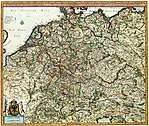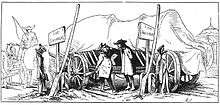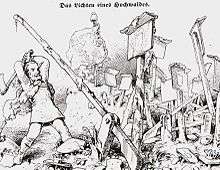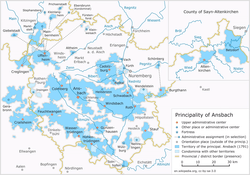Kleinstaaterei
Kleinstaaterei (German: [ˌklaɪnʃtaːtəˈʁaɪ], "small-state-ery") is a German word used, often pejoratively, to denote the territorial fragmentation in Germany and neighboring regions during the Holy Roman Empire (especially after the end of the Thirty Years' War), and during the German Confederation in the first half of the 19th century.[1] It refers to the large number of nearly sovereign small and medium-sized secular and ecclesiastical principalities and free imperial cities, some of which were little larger than a single town or the surrounding grounds of the monastery of an Imperial abbey. Estimates of the total number of German states at any given time during the 18th century vary, ranging from 294 to 348[2] or more.


Part of a series on the |
||||||||||
|---|---|---|---|---|---|---|---|---|---|---|
| History of Germany | ||||||||||
 | ||||||||||
| Topics | ||||||||||
| Early history | ||||||||||
| Middle Ages | ||||||||||
| Early Modern period | ||||||||||
| Unification | ||||||||||
|
||||||||||
| German Reich | ||||||||||
|
||||||||||
| Contemporary Germany | ||||||||||
|
||||||||||
|
| ||||||||||



.svg.png)
Territorial fragmentation was compounded by the fact that, due to the haphazard territorial formation of many states or the partition of dynastic states through inheritance, a very large number of Holy Roman Empire states were constituted of non-contiguous parts, which resulted in countless enclaves or exclaves.
In the summer of 1789, young Wilhelm von Humboldt and some friends, leaving Brunswick, capital of the Principality of Brunswick-Wolfenbüttel, for France to observe the revolutionary events unfolding in Paris, needed to enter and exit six duchies, four bishoprics and one free imperial city (Aachen) before reaching the French border.[3]
History
The powerful and autonomous German stem duchies, that already existed before the demise of the Carolingian Empire and the formation of East Francia during the 9th century have basically shaped the federal character of the kingdom. Unlike in other European kingdoms, a college of the Imperial princes elected the king from among the territorial dukes after the Carolingian line had died out around the year 898.[4] This system prevented the development of a strong centralized monarchy as local rulers, who sought to promote their own interests and autonomy often rebelled against the sovereign ruler and conflicts had to be solved on the battlefield.[5]
The imperial interregna between 1245 and 1312 and between 1378 and 1433 increased political instability and strengthened the communal movements, such as the Swabian League of Cities, the Hanseatic League and the Swiss Confederacy. Feuding among the lesser Territorial nobility, who received their fief from the territorial princes lead to conflicts such as the Thuringian Counts' War and further territorial fragmentation. The Free imperial cities, many of them founded by the German kings and emperors during the 10th to 13th century, had initially been administered by the Imperial nobility (Vögte), direct vassals of the emperor. These towns gradually gained independence as their patrician city magistrates assumed full control of administration and justice.[6][7][8][9]
The political fragmentation of the Empire was the single most salient characteristic of German history throughout the early modern period; it underlay and conditioned development in all areas of public life.[10]
While in other European kingdoms such as France, coherent nation states emerged as a result of early modern ideas of political concentration and centralisation, the Habsburg dynasty, who already controlled the Duchy of Austria, Bohemia and Hungary, ruled the Holy Roman Empire since 1438 and managed to permanently occupy the imperial throne until 1806 (with a brief exception between 1742 and 1745). The Habsburg family, however pursued its Grand Strategy policy, that focused on long-term dynastic reign at the center of a vast, multi-layered and multi-ethnic realm against Bourbon France and the Ottoman Empire. The imperial lands rather served to retain buffer zones, that were at odds with any concepts of patriotism and national identity.[11][12]
In 1495 emperor Maximilian I attempted to reform the empire. An Imperial supreme court (Reichskammergericht) was established, imperial taxes were levied, and the power of the Imperial Diet (Reichstag) was increased. The reforms, however, were frustrated by the continued territorial fragmentation of the Empire.[13] The Protestant Reformation represented a major threat to imperial integrity. Emperor Charles V stated in 1546: ...if we failed to intervene now, all the Estates of Germany would be in danger of breaking with the faith.... With the 1548 Augsburg Interim he attempted to reconcile the religious schism in Germany, but instead only prompted new Protestant defiance.[14]
Since the 17th century the Kingdom of Prussia emerged as the second dominant power, that also incorporated substantial non-German territories and lands beyond the borders of the empire, while excluding major parts of Germany proper.[5][15]
Apart from these two states, the Holy Roman Empire consisted of hundreds of small, German-speaking principalities, most of which derived from successive dynastic splits (feudal fragmentation), sometimes reflected in compound names such as Saxe-Coburg; some of these were united through royal marriages, although the resulting entity was often not a contiguous territory. During the early modern period, these small states modernised their military, judicial, and economic administrations. These hardly existed at the imperial level, and the emperor was little more than a feudalistic confederal figurehead, without political or military clout. After the Reformation, the Empire's small states were divided along religious lines. Those headed by Roman Catholic dynasties faced those ruled by Protestant dynasties in the Thirty Years' War and other conflicts.[16][5]
After French Emperor Napoleon Bonaparte forced the Holy Roman Emperor, Francis II, to dissolve the Empire in 1806, Kleinstaaterei was altered, but not eliminated. Through the elimination of territories ruled by prince-bishops (secularisation) and through the consolidation of neighbouring principalities, enclaves and exclaves, Napoleon reduced several hundred states into a relative concentration of a little over two dozen states in the Confederation of the Rhine. This confederation did not survive Napoleon's military defeat at the hands of the allies, but the previous principalities were not entirely restored. Prussia and the Austrian Empire—the successor state to the Habsburg Monarchy—were the only major German powers, and neither had been part of the Confederation of the Rhine. The victorious allies, including Prussia and Austria, decided at the Congress of Vienna (1814–15) on widespread dynastic restorations, although some of Napoleon's consolidations were maintained, and Austria and Prussia helped themselves to some formerly independent territories. The resulting territorial division resulted in a consolidated version—around 40 states—of the pre-Napoleonic Kleinstaaterei.
The rise of nationalism across Europe brought movements striving for "nation-states", each governing an entire (ethno-cultural) people. German nationalists began to insist on a unified Germany. The call for a unified nation-state was one of the central demands of the Revolutions of 1848, but the ruling dynasties of the smaller German states and of multinational Austria and Prussia managed to resist nationalist efforts at unification. Also German writer and statesman Goethe had always opposed this, writing: "Frankfurt, Bremen, Hamburg, Luebeck are large and brilliant, and their impact on the prosperity of Germany is incalculable. Yet, would they remain what they are if they were to lose their independence and be incorporated as provincial cities into one great German Empire? I have reason to doubt this."[17]
Only after Prussian Chancellor Otto von Bismarck gradually built a unified German state under the Prussian royal house of Hohenzollern did Kleinstaaterei largely end in 1871 with the founding of the German Empire. (The only surviving petty states—Luxembourg and Liechtenstein—lie at the periphery of the German-speaking world.) The founding of the German Empire created a largely German nation-state. While the German Empire excluded the partly German but multinational Habsburg domains of Austria–Hungary, it included a substantial Polish minority in parts of eastern Prussia and other minorities along its northern and western borders.[18] The unification of the German Empire put Germany on the map as a major European power, albeit too late to become a major colonial presence. Internally in the nation some of these fragmented boundaries and small political units continued to exist until the modern States of Germany were established in the Federal Republic after World War II.
The decentralised nature of Kleinstaaterei made it difficult for the German economy to live up to its potential. Varying systems of weights and measures, different currencies and numerous tariffs impeded trade and investment, although the creation of the German Customs Union had begun to lift these barriers.[19] The startling rapidity of Germany's economic growth after unification under Bismarck provided further evidence that the Kleinstaaterei had been economically repressive. The system did contribute to cultural diversity within Germany, and the numerous rival courts—though usually politically insignificant—often gained some renown through patronage.
Modern German usage
Today, the term Kleinstaaterei is sometimes used in the German media and elsewhere in a figurative sense to describe the German political system of federalism in a critical way, especially referring to its seeming inefficiency to decide on reforms in political fields that are the responsibility of the Länder (states of Germany) and thus are under the auspices of sixteen different administrations. As of 2010, Kleinstaaterei is most often invoked in matters of educational policy, such as the difficulties caused by the different school systems for children of families that move from one state to another.
See also
References
- Historian J. Whaley defines Kleinstaaterei as "A (pejorative) term coined in the early 19th century to denote the extreme territorial fragmentation of the Reich". J. Whaley, Germany and the Holy Roman Empire (1493–1806), Oxford University Press, 2011, vol. 2, p. 653 (Glossary).
- The Times, Atlas of European History, Harper Collins, 1994, p. 127
- E. D. Brose, German History 1789–1871, From the Holy Roman Empire to the Bismarckian Reich, Berghahn Books, 1997, p. 4.
- "Lambert von Spoleto". Deutsche Biographie. Retrieved 17 May 2019.
- Eric Solsten (August 1999). Germany: A Country Study. DIANE Publishing. pp. 24–. ISBN 978-0-7881-8179-5.
- "The Imperial Nobility of Germany". Holy Roman Empire Association. Retrieved 14 April 2019.
- Holland, Arthur William (1911). . In Chisholm, Hugh (ed.). Encyclopædia Britannica. 14 (11th ed.). Cambridge University Press. p. 342.
- "Warum gibt es die Schweiz? - 2.1.1. Das Heilige Römische Reich". Unterrichstools Schweiz. Retrieved 17 May 2019.
- Nicholas, David (1997). The Growth of the Medieval City: From Late Antiquity to the Early Fourteenth Century. Longman. pp. 69–72, 133–42, 202–20, 244–45, 300–307.
- John Gagliardo, Germany Under the Old Regime, 1600-1790, Longman, 1991, p. viii.
- A. Wess Mitchell (26 June 2018). The Grand Strategy of the Habsburg Empire. Princeton University Press. pp. 307–. ISBN 978-1-4008-8996-9.
- Mikulas Teich; Roy Porter; Former Professor of the Social History of Medicine Wellcome Trust Centre for the History of Medicine Roy Porter (6 May 1993). The National Question in Europe in Historical Context. Cambridge University Press. pp. 153–. ISBN 978-0-521-36441-6.
- Joachim Whaley (2012). Germany and the Holy Roman Empire: Volume I: Maximilian I to the Peace of Westphalia, 1493-1648. OUP Oxford. ISBN 978-0-19-873101-6.
- Daniel H. Nexon. "The Struggle for Power in Early Modern Europe" (PDF). Princeton University Press. Retrieved 18 May 2019.
- Reinhard Bendix (8 April 1980). Kings Or People: Power and the Mandate to Rule. University of California Press. pp. 141–. ISBN 978-0-520-04090-8.
- Markus A. Denzel. "State and Finance in the Holy Roman Empire from c.1650 to c.1800" (PDF). University of Helsinki. Retrieved 17 May 2019.
- Hans-Hermann Hoppe (1 February 2012). "The Politics of Johann Wolfgang Goethe". Mises Institute. Retrieved 17 May 2019.
- Stefan Berger. "Building the Nation among Visions of German Empire". Stefan Berger/Alexei Miller (Eds.): National Empires, Pp. 247-308. Academia. Retrieved 19 May 2019.
- Tilly, Richard (1967), "Germany: 1815–1870", in Cameron, Rondo (ed.), Banking in the Early Stages of Industrialization: A Study in Comparative Economic History, Oxford University Press, pp. 151–182